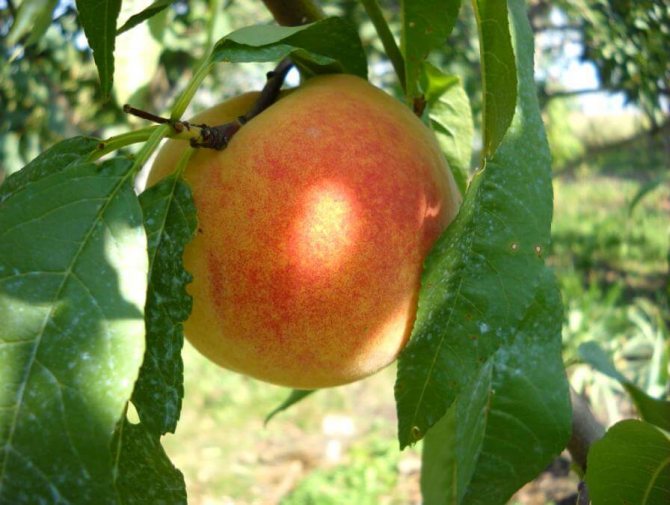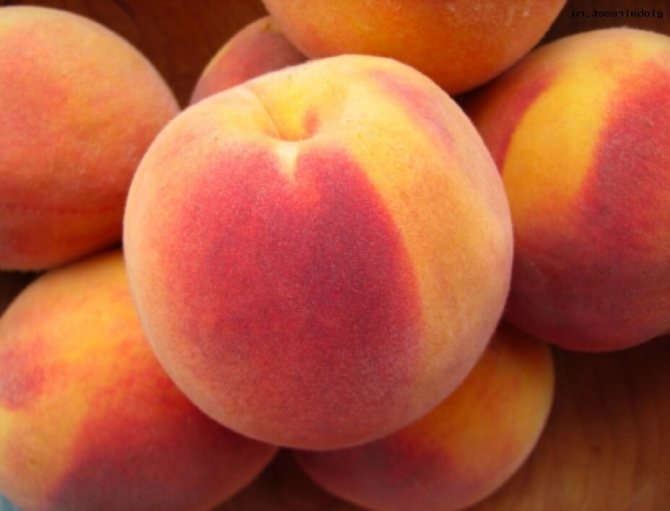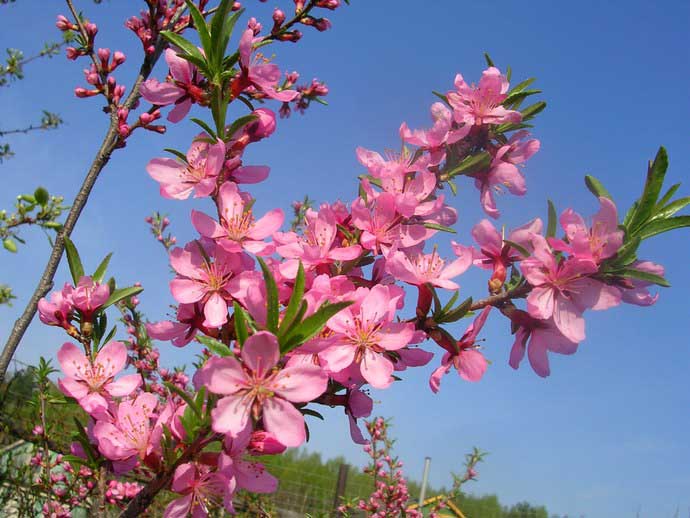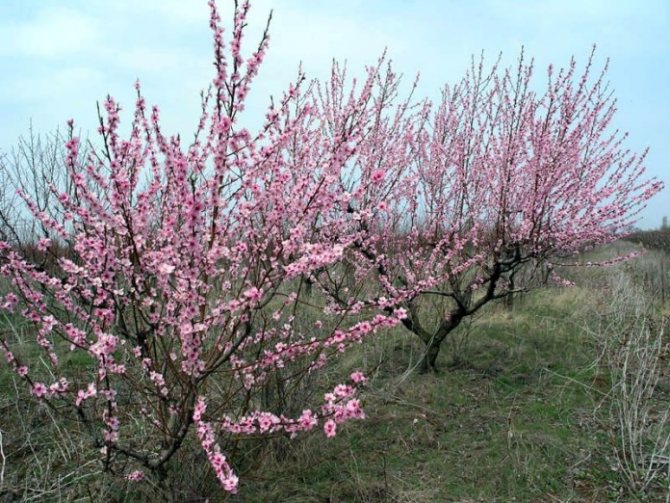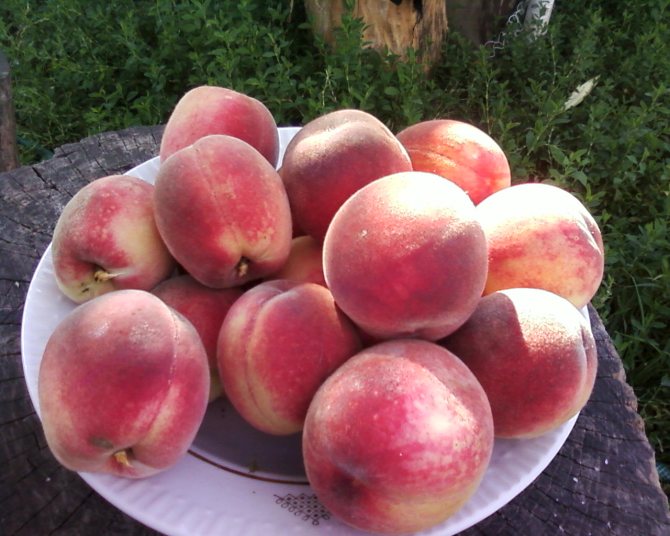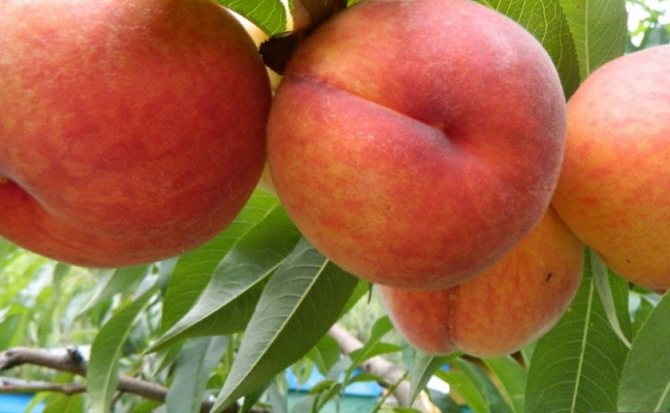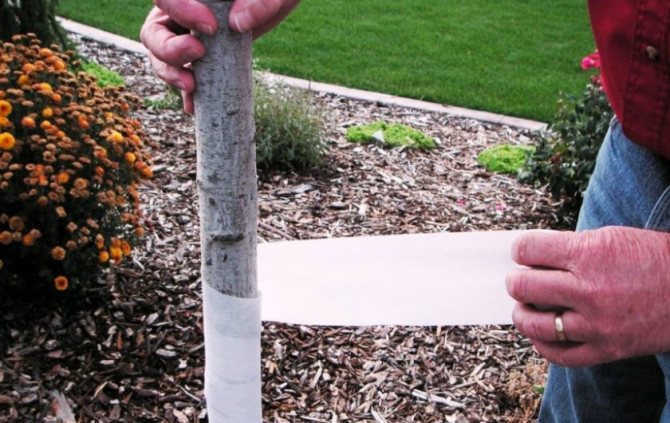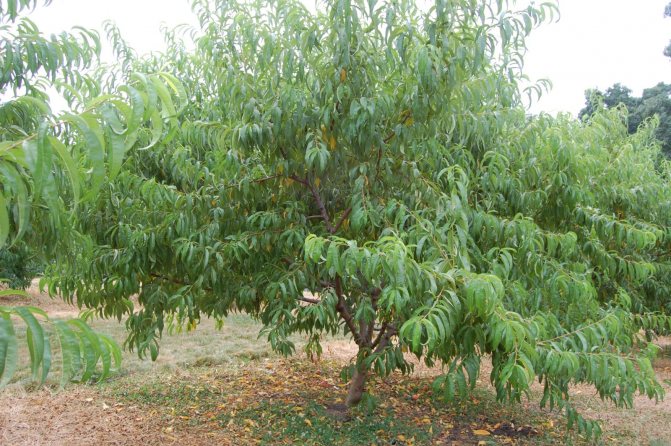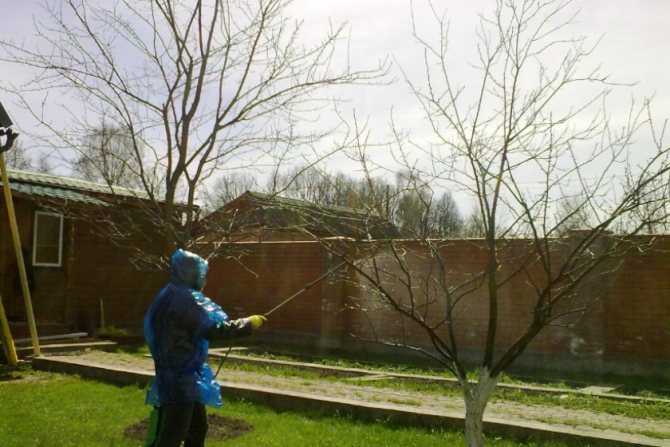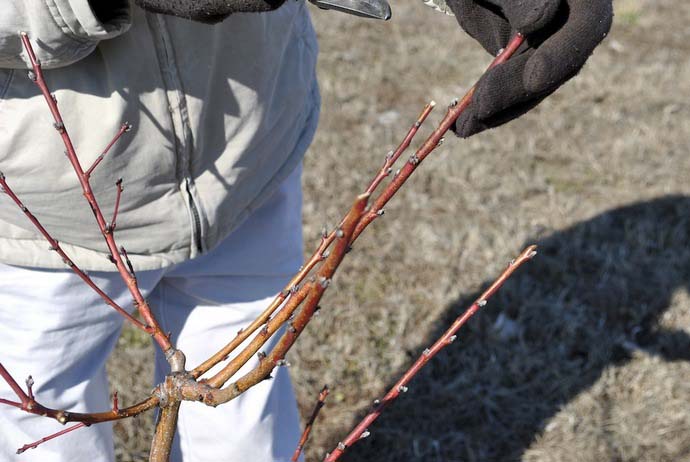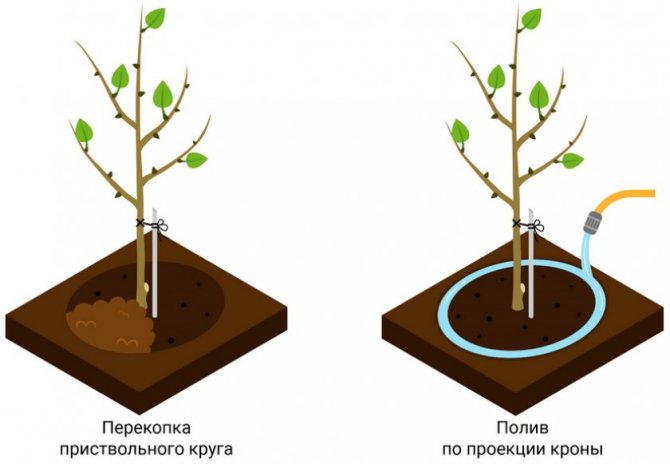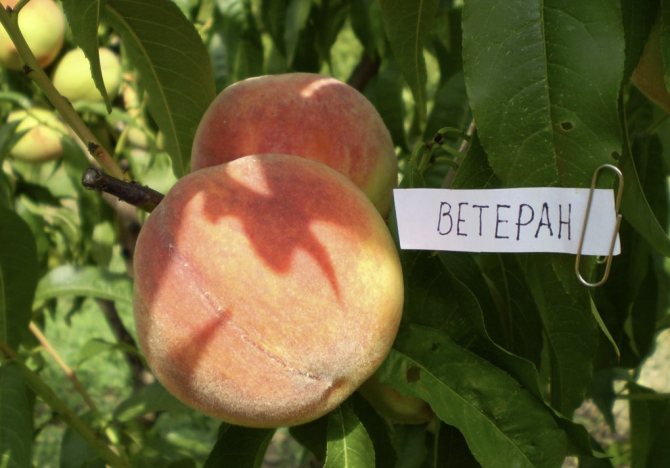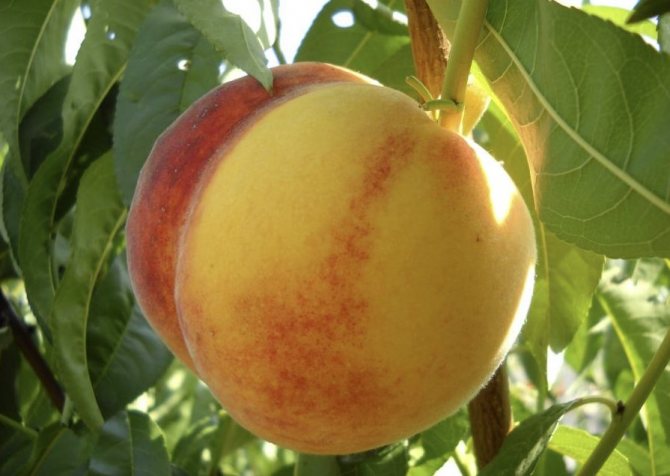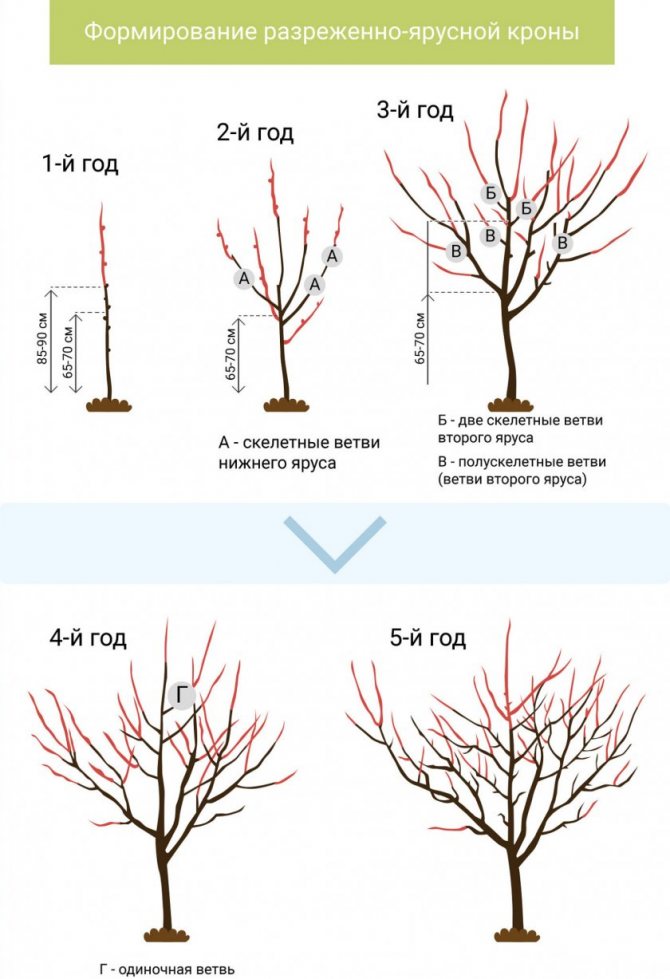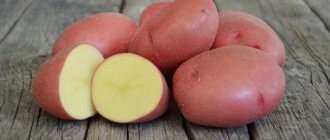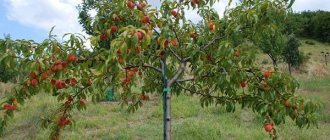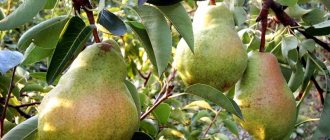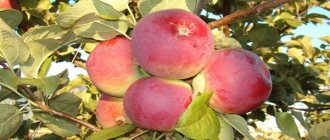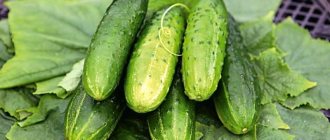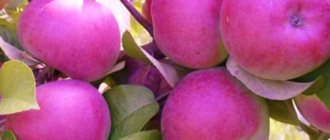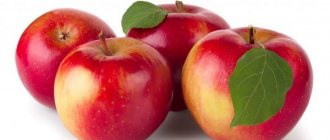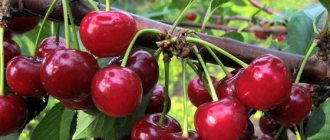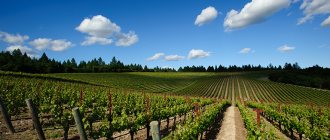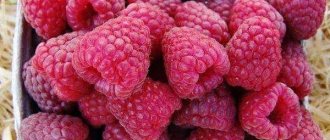Peach is a fast-growing, short-lived culture, characterized by intensive growth and a rapid pace of passage of age periods. The buds are early ripening, therefore, in young individuals from the wintering bud during the growing season, a branched system of shoots with lateral branches of the second and third order is formed. Along with this, it should be noted the high awakening ability of the buds and the shoot-producing ability, due to which the crown of 1-2-year-old trees is usually strongly thickened.
Not so long ago, the peach was considered an exceptionally thermophilic crop and could only be grown in southern regions with a mild climate. Modern varieties of peaches can withstand frosts down to -28C, which allows the plant to be planted in all latitudes. Flowering, fruiting and ripening of fruits directly depends on the variety (early, middle and late ripening), the climate of the area where the tree is grown, as well as on the growing conditions and care. The gardener should also remember that all varieties of fruits ripen in the greenhouse. For planting in open ground, you need to choose those of them, the fruits of which ripen during the growing season.
Trees with a fan-shaped crown are grown in greenhouse conditions. Each plant requires a 3/2 m area. The greenhouse should receive sunlight, in the summer at least half a day.
The varieties of early ripening include those whose fruits ripen in July-August. Middle and medium - late ripening varieties ripen in the third decade of August or early September. Late peaches are harvested in September-October.
What is the best peach variety to plant
When choosing which variety of peach to plant is best, you need to take into account that early varieties come into fruiting 2-3 years after planting. High yields begin to be yielded in 4-5 years. Late fruits begin to bear fruit at 5-6 years. Many varieties are self-pollinated, but in order for a tree to produce a rich harvest, it is recommended that 4-5 trees be adjacent to ensure cross-pollination.
In the peach culture, a large number of generative buds, ovaries and, as a result, an abundance of fruits are laid annually, but they can be small or poorly colored. To obtain high quality fruits, you need to regularly thin out the crown, which will provide good illumination. This work will help regulate the rate of fruiting. In the absence of pruning, trees age early, yields decrease.
The most common varieties are:
Advantages and disadvantages of the variety
- The most significant benefits of this fruit variety are:
- high productivity;
- stable fruiting;
- taste and aroma, marked by high marks from experts;
- frost resistance is a characteristic that is the main criterion for the popularity of the variety in different climatic regions;
- high immunity to pests and diseases inherent in fruit trees, resistance to powdery mildew;
- good transportability, without loss of presentation.
- Disadvantages of the Ambassador of Peace are called:
- fragility of branches that can break under the heavy weight of the crop, therefore, observance of the rules for pruning is an extremely important point in the process of tree care.

Photo gallery
Peach variety "Kievskiy early" (with description and photo)
In Russia, the peach variety "Kievskiy early", bred by crossing the peaches "Kashchenko 208" and "Gros Mignon", has won great popularity. It is a short tree or bush, reaching 4-5 m, which makes it quite convenient for harvesting. The crown is round, compact, of medium density.
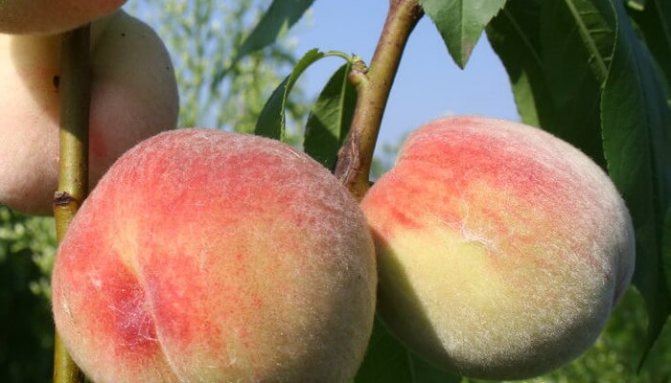

Fruits weighing 60-100 g, round in shape with a pronounced abdominal seam. Skin tone ranges from light yellow to off-white with a slight blurred blush.
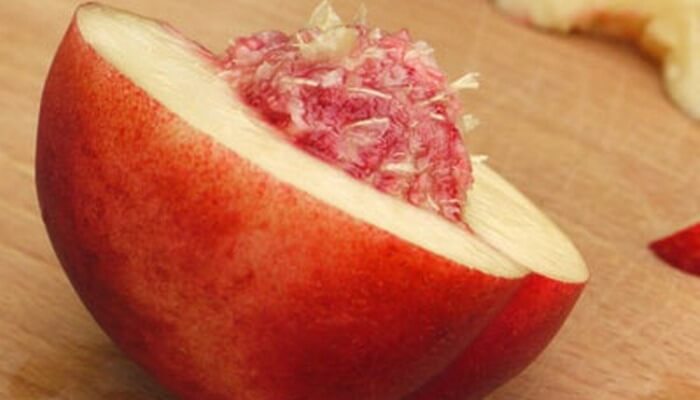

The pulp is white, without redness near the stone, juicy, dense, sweet, with a barely noticeable sourness, pleasant to the taste. In a warm climate, fruits ripen on July 15-20. When describing the Kiev early peach, it should be noted that the winter hardiness of the tree and flower buds is high, so the variety can be grown in any latitude. The yield is high, about 60 kg of fruits are obtained from one tree. "Kievsky early" is resistant to powdery mildew, curly leaves and other diseases.
Characteristics of the variety
The peculiarity of the peach is its endurance and the ability to bear fruit in the second year after planting. With correct pruning, the shrub does not take up much space on the site, it is not afraid of pests.
Drought resistance and frost resistance
The Voronezh Bush variety is genetically predisposed to withstand high temperatures without constant watering. Feels comfortable all day long in direct sunlight. The more UV light, the sweeter the fruit. As with any plant, moderate watering is necessary; at high humidity, the culture loses some of the ovaries.
Voronezh bush peach is a winter-hardy variety created especially for Central Russia. It tolerates frosts of -35 ° C, in case of freezing of the root system, it fully recovers in the spring. In order to prevent the death of the plant, the Voronezh Bush takes cover for the winter.
Does the variety need pollinators
The peach has bisexual flowers - the cultivar does not need pollinators. When placing on a site, it must be borne in mind that the shrub will not yield a crop if a tall fruit tree is growing nearby. The crown will become an obstacle to the penetration of solar heat and light.
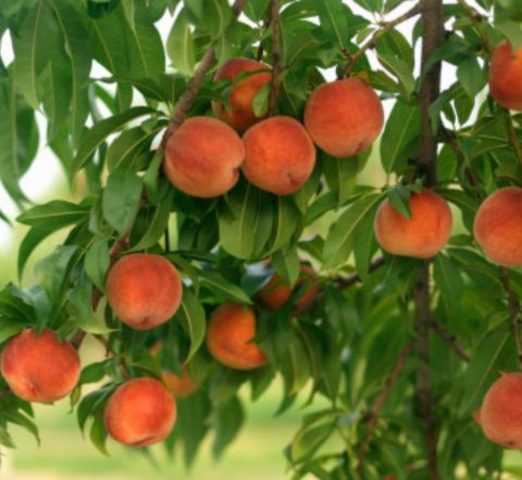

Productivity and fruiting
According to the description of the variety, the Voronezh peach is a medium early crop, the harvest is carried out in mid or late September, depending on the weather. Bears abundantly due to self-pollination. What makes this variety attractive is its ability to yield the next year after planting. On average, 20-30 kg of fruits are removed from one tree. Contains more glucose than acids, therefore the taste of the variety is sweet with a slight sourness and aroma inherent in the culture. The peach is tightly fixed on the stalk, therefore, having reached biological ripeness, the fruit does not crumble.
Scope of the fruit
Due to its compactness and high yield, the Voronezh Kustovoy variety is grown on a personal plot and on farms. For the most part, it is consumed fresh. The peach is preserved without losing its taste and aroma within 6 days, it tolerates transportation well. At home, it is suitable for preparing blanks for the winter: compote, jam. Industrial cultivation of peaches is carried out for the purpose of supplying to the trade network and obtaining the wort for juice.
Disease and pest resistance
The fruit is immune-adapted to temperate climates. The majority of infections and garden pests affecting crop varieties in southern latitudes are not scary for the Voronezh bush peach. Fungal diseases infect the plant if the moisture level is exceeded. For this reason, the spread of aphids is possible.
Advantages and disadvantages of the variety
The advantage of the "Voronezh cluster" is:
- tolerance to low temperatures;
- complete recovery after freezing;
- yield;
- self-pollination;
- compactness of the bush;
- resistance to fungal diseases: clasterosporium disease, powdery mildew;
- high appreciation of taste;
- well stored and transported.
The disadvantages include the need for shelter for the winter, constant pruning, poor separation of the bone from the pulp.
Peach "White Swan": photo and description
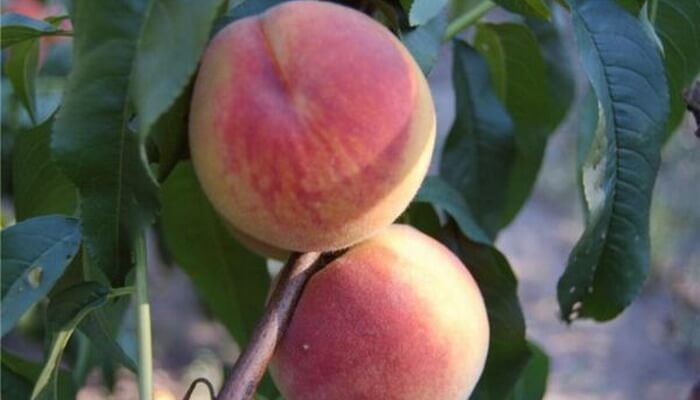

Peach "White Swan" is a medium-sized tree up to 6 m in height. Its crown is spreading, broadly oval. Fruits are round, large, weighing 150-200 g. The skin is intensely yellow, with a pink blush. The pulp is white-creamy, juicy, with a high sugar content, due to which the variety "White Swan" is considered a dessert. Fruit ripening occurs at the 20th of August. This peach is high-yielding, self-fertile. Withstands prolonged droughts. Increased frost resistance, tolerates temperatures up to - 25 ° C. Flower buds are not damaged by frost. The fruits are transportable. They are used fresh, and also go to the manufacture of compotes, juices, preserves, desserts.
Harvesting and storage rules
Peaches are harvested when their color becomes deep yellow with bright carmine blotches on 80% of the fruit area. They do not ripen on the tree at the same time, so harvesting is done within several days. If the fruit is transported over long distances, it is harvested 5 days before it is fully ripe.
Indoors, fruits can last for 5 days. For long-term storage, they are placed in a refrigerator or basement. When keeping peaches in boxes, each fruit is wrapped in paper. Fruits can be dried, frozen, as well as prepared from them compotes, juices, preserves, jams.
The variety of fruit crops makes it possible to choose varieties suitable for growing in a particular region, in accordance with taste preferences and intended use. Further in the article we will talk about the popular peach variety Ambassador of the World, its advantages, cultivation technology and care.
Description of the peach "Ambassador of Peace"
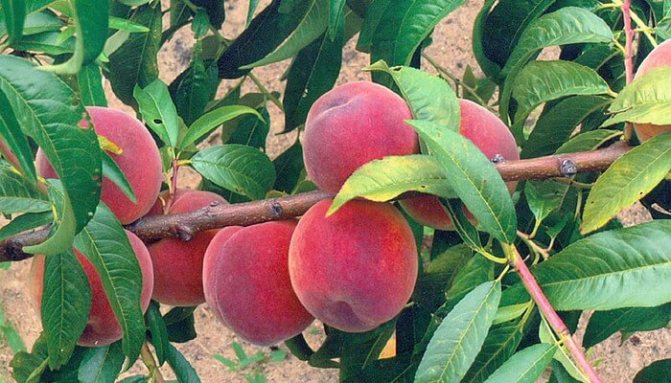

Peach "Ambassador of Peace" - a tree of medium height, reaching 5-6 m, with a spherical spreading crown. Flower buds are laid on all types of shoots. The fruits are round, very attractive in appearance. Their mass is 180-220 g. The skin is yellow - carmine. The pulp is yellow, quite juicy, fibrous, and has a pleasant taste. The fruits ripen in the second half of August. "Ambassador of Peace" is frost-hardy, with high resistance to spring frosts. Self-fertile. Brings regular rich harvests. To prevent tree branches from breaking under the weight of the fruit, a normalizing annual pruning is required.
The subtleties of growing varieties
Stone fruits bear fruit early, so it is very important to plant them at the right time. Also, fruiting depends on the choice of the seedling and on its correct planting.
Landing dates
The peach is planted in the ground in the spring at an air temperature of at least + 5 ° C. By the beginning of the procedure, sap flow should not begin in the seedling, so it will more easily transfer the planting. Experienced gardeners recommend planting the Ambassador of Peace in the fall, since at this time he will direct all his forces to rooting, he does not need to build up greenery during this period. Depending on the region, the peach is planted from mid-September to mid-October.
See also
How to plant a seed and grow a peach from it at homeRead
Purchase of seedlings
In order not to be disappointed in the purchase in a few years, when the peach begins to bear fruit, it is necessary to purchase seedlings in nurseries or garden centers. Examine the root system of the tree. You can check its viability by cutting the spine with a knife. If the core of the cut is white, the peach is healthy and will take root quickly. The place where the scion grows with the stock should be even, without sagging.
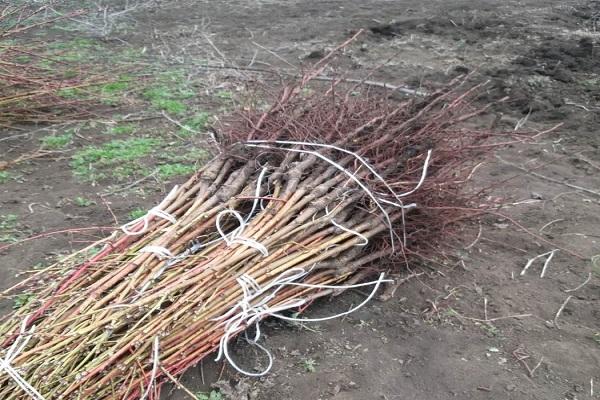

Seat preparation
The site for the peach Ambassador of Peace is picked up well-lit by the sun.If the place is shaded, the fruits will grow smaller than stated in the characteristic of the variety, and will also not be as sweet and aromatic. Peach will grow best on the south and southwest side of the plot. Fertilizer of the following composition is laid in the planting hole:
- 10 kilograms of rotted manure;
- 300 grams of wood ash;
- 50 grams of superphosphate and potassium chloride.
The fertilizer is mixed with the soil from the planting pit.
Important! Groundwater should not approach the soil surface closer than 1.5 meters.


Planting scheme and process
The Ambassador of Peace peach is planted as follows:
- A hole is dug 50-80 centimeters deep and wide.
- Drainage from sand, small stones, expanded clay is laid at the bottom.
- Then the prepared substrate is poured with a slide.
- Roots are laid out in the center of the slide, which are covered with the remaining soil.
- The peach circle is watered abundantly.
The trunk circle is mulched with sawdust or peat, the seedling is tied to a hammered peg.
Greensboro peach
Greensboro peach introduced in America in 1981. It has many positive qualities that cover some of its disadvantages. It is a vigorous tree with a wide spreading crown. Annual shoots of medium length and thickness, smooth, burgundy, have short internodes. The flower buds are large, ovate, pointed from above. The leaves are thick, leathery, with the ends bent down, 16 cm long. The surface of the leaf plate is smooth, shiny, dark green, the lower part is greenish-gray. The flowers are large, with wide pale pink petals. The pedicel is short. Fruits are spherical, slightly elongated, weighing 100-120 g, with a blunt top and a small depression, which is a characteristic feature of the variety. The peel is coarsely pubescent, greenish-creamy, with a blush in the form of dots, occupying? part of the fruit.
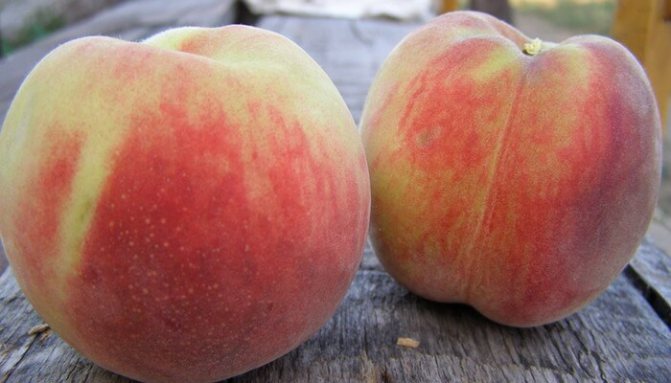

The pulp is very juicy, fibrous, fragrant, the same shade as the peel. It tastes sweet and sour. The stone does not separate from the pulp, often cracks. Winter hardiness of the Greensboro variety is high. Its disadvantage is the poor transportability of the fruit.
Peach variety "Fluffy early": photo and description
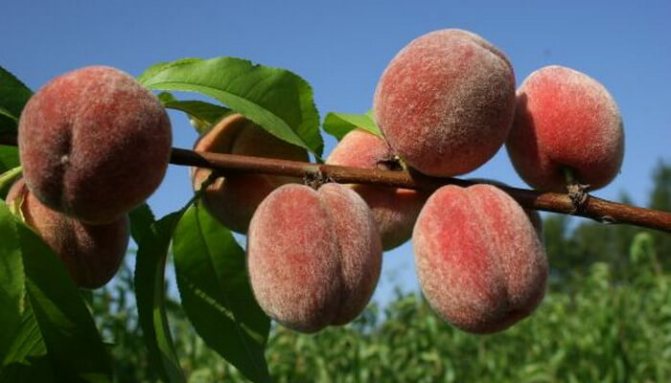

Peach "Fluffy early" - a tree up to 5-6 m in height. The crown is broadly oval, slightly spreading. Fruits are elliptical with a rounded apex, in which there is a small depression, weighing 70-100 g. The peel is of medium density, with a weak ventral seam and tomentose, cream shade with a bright red blush. The pulp is loose, fibrous, tender, white, sweet taste. The "Fluffy Early" peach variety is valued for its good winter hardiness and annual, rich harvests. The disadvantages include satisfactory taste of the fruit.
Description and photo of the peach "Golden Jubilee"
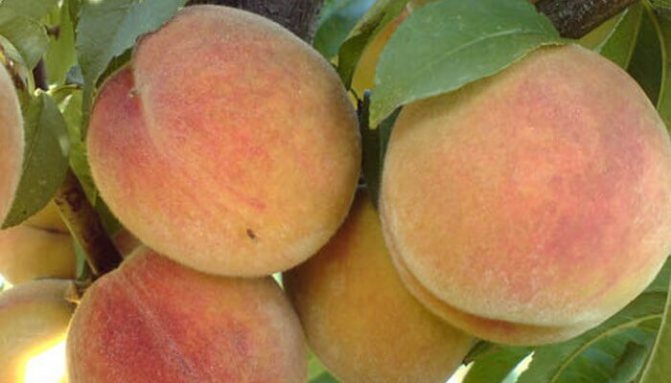

Peach "Golden Jubilee" Is an American variety, bred in 1921. It is a medium-sized, fast-growing tree with a height of 4-5 m. Fruits are large, weighing 130-140 g, spherical, with a weakly expressed abdominal suture, deepening towards the base. At the top there is a narrow, deep funnel. The skin is dense, slightly pubescent, golden yellow with a dark red blush.
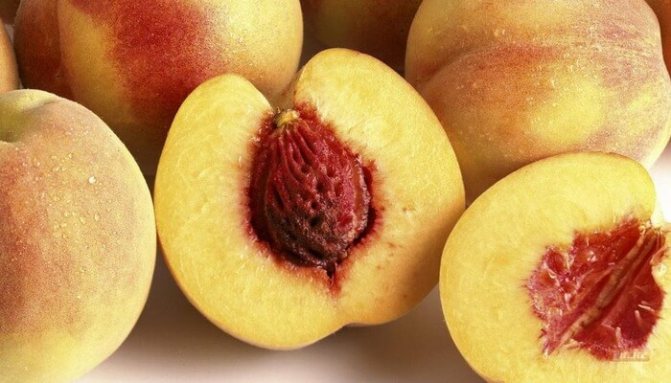

The pulp is juicy, non-fibrous, yellow-orange, on the palate sweet with sourness. The stone separates well from the pulp. Fruit ripening occurs in the second half of August. The description of the "Golden Jubilee" peach will be incomplete without mentioning its frost resistance and winter hardiness of flower buds. Fruiting occurs at the age of 3. Trees give annual, bountiful harvests (40-50 kg per bush). The fruits of this variety are transportable. Stored in storage for up to 8 days.
What the Golden Jubilee peach looks like can be seen in the photo below:
Peach variety "Favorite Morettini"


Peach "Favorite Morettini" - an early variety bred in Italy. Medium-sized tree with a spreading crown. Fruits are round-oval, small and medium, weighing 70-90 g, with a superficial ventral seam.The skin is dense, velvety pubescent, yellow, with a red dotted and streaky blush, which occupies most of the fruit. The top is pointed. The pulp is tender, fibrous, juicy, aromatic, sweet, with a good taste. The bone is not separated from the pulp. The fruits ripen in early July. Transportability is average. The shelf life is 3-4 days. The yield of this variety is average. Winter hardiness is high.
Peach variety "Veteran" (with photo and description)
The Veteran peach variety was bred in Canada. It is a weakly growing tree up to 4 m in height with a spherical thickened crown. Fruits are round in shape, weighing 130-180 g. The peel is yellow, with a pronounced blush, which occupies most of the fruit. The pulp is yellow, of medium density, juicy, aromatic, sweet, with sourness, good taste. Maturation occurs on August 10-15.
The description of the Veteran peach is in many ways similar to the description of other winter-hardy varieties of this culture. The yield of the tree is high. Up to 50 kg of fruits are obtained from one individual. This variety is distinguished by an abundance of flower buds, which ensures stable fruiting after harsh winters. The advantages of the Veteran peach include good keeping quality and transportability of the fruit. The tree is resistant to powdery mildew, clasterosporium disease.
Further care of the peach
Throughout the season, the peach is looked after: watered, fed, removed weeds around the tree, loosened the soil, cut the crown if necessary.
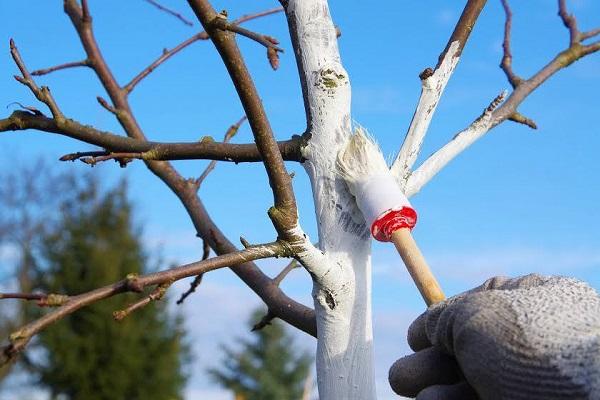

Watering mode
The Ambassador of Peace is a drought-resistant variety, but, nevertheless, it requires watering for full growth and fruiting. The earth is abundantly moistened when planting, then at the beginning of June. The main mass of peach roots is at a depth of 70 centimeters, so at least 20 liters of water is poured under each tree. During dry summers, the Ambassador of Peace is also irrigated in July and August.
Top dressing of a tree
In the year of planting, the peach is not fed. The fertilizer applied during planting is enough for him. The next spring, furrows are made around the tree, and urea is introduced into them (50 grams per square meter). Before flowering, fertilizers are applied with a predominance of potassium. After fruiting, the soil is fed with a mixture of 40 grams of superphosphate and 50 grams of calcium chloride.


Pruning features
The crown of the peach is formed from the first years of his life. Cropping is necessary for the following reasons:
- more sunlight comes to the fruits, due to which they become sweeter and more aromatic;
- thinning the crown prevents the appearance of diseases;
- pruning regulates the abundance of fruiting and the convenience of harvesting.
See also
How to grow nectarine correctly, variety selection, planting and care, breeding methodsRead
The best pruning time is spring, budding period. It was at this time that you can see which branches wintered well, and which ones require removal. For the procedure, pruners, a hacksaw, and a garden knife are used. After cutting off the branches, the places of the cuts are sealed with garden pitch.
Wintering specifics
Peach Ambassador of Peace is a thermophilic culture. In autumn, trees are mulched with peat or compost to a height of 10-15 centimeters. In regions with a temperate climate, shelter will be required, especially for young seedlings. The structure is constructed from stakes driven into the ground and burlap wrapped around them. The twigs should be the same height as the tree.


Instead of burlap, you can take cardboard and wrap it around the trunk. Several layers of nonwoven fabric are wound on top.
In the southern regions, it is enough to sprinkle a peach with soil to a height of half a meter.
Peach protection from diseases and pests
The Ambassador of Peace is resistant to disease and pests. But due to improper care, he can be struck by some types of fungal diseases and harmful insects.This can happen due to the thickening of the crown, too frequent watering of trees, the presence of weeds in the trunk circle.
Observing agricultural techniques, the gardener will prevent the appearance of peach misfortunes. For prevention, plants are sprayed in the spring, before bud break, with copper-containing preparations. In autumn, trees are treated with a solution of sulfur and lime, or insectofungicides.
Note! Correct implementation of agrotechnical techniques will prevent the appearance of most diseases and pests.
Peach variety "Redhaven": photo and description
The Redhaven peach variety was bred in the USA in 1940. It is a short tree up to 5 m in height, with a wide-cone-shaped crown of medium density, up to 10 m wide. The bark of the branches is gray-brown, strongly cracking. Vegetative buds are small, conical. Generative - small, elongated to the top. The leaves are large, lanceolate, finely serrated along the edge, up to 17 cm long, up to 4 cm wide. The leaf blade is smooth, shiny, dark green. The flowers are bell-shaped, bright pink, of medium size.
Fruits are round or rounded-oval, weighing up to 140 g. The skin is dense, bright yellow, with a blurred red blush and delicate pubescence, easily removed from the fruit. There is a depression and a slight bulge at the top. The pulp is creamy, friable, fragrant, with a pleasant taste. The stone is easily separated from the pulp when the fruit is fully ripe. Ripening August 5-10.


Peach "Redhaven" translated from English. means "red paradise". The variety received this name for the attractiveness and high taste of the fruit. Its advantages also include regular and abundant fruiting (from 50 to 100 kg of fruits from one bush), resistance to curly leaves. Redhaven is self-pollinated, but peaches of other varieties are planted in the neighborhood to increase yields. Due to the abundance of fruits, it is possible for them to shrink and overload the branches with the harvest.
Peach planting rules
In order for the Veteran variety to take root and grow healthy, a number of rules must be observed when planting. Mistakes can even lead to the death of the tree. This is especially true when choosing a place for a peach and meeting planting dates.
Recommended timing
There is no consensus among gardeners about planting a peach: some prefer to do it in the fall, others in the spring. If you carry out the procedure before winter, then there is a risk that the young tree will not have time to root well and freeze. Spring planting is risky because the peach will suffer from pests and diseases.
This procedure cannot be performed in all regions in the fall. In temperate climates, only spring planting is possible. It makes sense to root a peach in autumn if winter comes in accordance with the calendar and the temperature does not drop below -15 ° C. That is, the tree should have 8-10 weeks in stock before frost in order to get stronger and survive the winter. In autumn, as a rule, there is more choice of seedlings, and they also have leaves and a developed root system, which makes it possible to judge their quality.
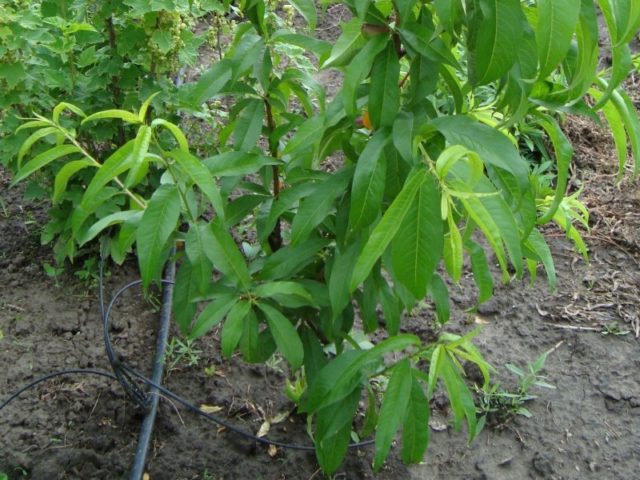

The Veteran Peach is planted when it is dormant. For the south of Russia, north-east and north-west of Ukraine, the recommended date is September 10-15. In Crimea, Krasnodar Territory and southern Ukraine, the Veteran peach can be planted until October 20, and if winter is predicted to come later, then until November 10.
In the temperate climate of the Ural and Siberian regions, peaches do not have time to form ovaries and ripen. Such trees can only be grown there in greenhouses and greenhouses.
Choosing the right place
Peach is picky about heat and sunlight. The culture does not tolerate transplantation very well, so you need to choose a place very carefully. The peach tree grows well in heat and drought conditions, but a draft and excessive dampness can destroy it.
They try to place the seedling on the south side of the site. It should not be overshadowed by any structures or other trees.On the north side, it is better to protect the peach with a fence or hedge, placing the seedling 2 m from the wall.
The tree should not be grown in lowlands, because the soil there often becomes waterlogged and cold air stagnates. Groundwater should pass at least 1.5 m from the surface. Peach trees grow very well on the southern or southeastern slopes of the hill.
The seedling should not be placed in the place where nightshades or melons grew before. Fungal diseases can be transmitted from sunflowers, strawberries, clovers and legumes. Rye and oats are good precursors for peach.
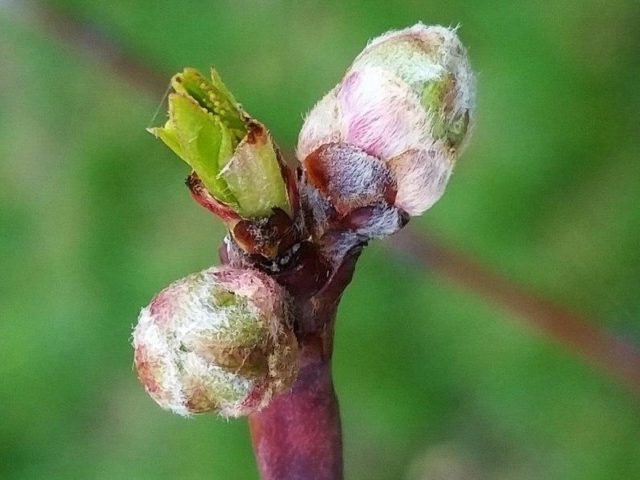

Yield indicators depend on the composition of the land. Sandy loam and loamy soils, as well as black soil, are best suited. There is sufficient humidity and a lot of lime. The peach tree will not grow on saline soils and places where there is a high content of carbonates.
Selection and preparation of planting material
The choice of a seedling is a very important stage, which determines how healthy and strong the tree will grow on the site for several years. The main points to consider when choosing a material:
- It is best to buy seedlings from nurseries located in the area of future peach growth.
- You should not take the product at the lowest price.
- It is not worth buying a peach too early - it must be dug out during the dormant period, otherwise it will not take root well. In good seedlings, the shoots are covered with bark and the buds are fully formed.
- The variety must be suitable for the climate of the area in terms of characteristics.
- The choice of the age of the seedling depends on the experience of the gardener - it is better for beginners to take a 2-year-old peach with a height of 1.5 m and with 3-4 branches, but skilled ones can cope with an annual seedling in the form of a rod 1 m in height.
- In appearance, the tree should be strong and sturdy, without signs of damage or disease. A peach has a fibrous root system, therefore, you should not take a seedling with one root. Sluggish leaves and flaky bark should alert you - you don't need to buy such a plant.
If you had to buy a seedling far from the site and you need to transport it, it is worth remembering that it is harmed by sudden changes in temperature and humidity. The roots should be wrapped in a wet cloth, covered with polyethylene on top and fixed.
Advice! Before planting, the trunk of the tree must be treated with melted paraffin - such a measure will protect the trunk from frost, rodents, sun and harmful insects, and in the spring will not interfere with the growth of branches and buds.
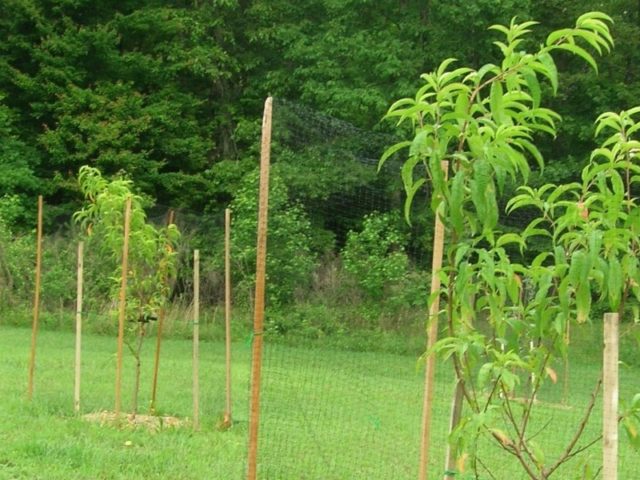

It is not recommended to immediately unpack the future tree - it is left in this form for 2 days. The day before planting, the seedling is placed in a container with clean water so that both the roots and branches are immersed. You can add a growth stimulant to the liquid.
Landing algorithm
2 months before planting, the site is cleared of stones and plant debris and dug up. Thus, the soil is saturated with oxygen. The size of the hole depends on the seedling, but it cannot be less than 0.5 m in depth, length and width. If necessary, drainage is made from expanded clay, pebbles or brick fragments. Its height is approximately 20 cm - this must be taken into account when planning the size of the pit.
The top layer of the earth is removed, but the rest of the soil from the pit is mixed with 2 buckets of humus and 0.5 kg of wood ash and poured back into a cone. The Veteran peach planting algorithm looks like this:
- First, two supports are stuck into the pit - if you do this after, you can damage the roots.
- Then 6 liters of water are poured into it and wait until it goes into the soil.
- Next, the seedling is placed vertically and the roots are spread along the earthen slide. The root collar should be 3-5 cm above the ground.
- The soil is placed back into the pit, filling it to the brim.
- The peach is tied to the supports, but not too tight.
- After the plant is watered using 8-10 liters of water.
- The soil should be lightly tamped, stepping back from the trunk about 0.5 m, it is necessary to form an earthen roller 15 cm high.
- Further, mulching is carried out with peat, sawdust, dry leaves.
Peach variety "Novoselovsky"
The Novoselovsky variety was bred by crossing one of the peach varieties with the Kievsky early. This is a dwarf tree up to 4 m in height. The crown is compact, rounded. Fruits weighing 50-70 g, round or round-oval, with a well-defined abdominal suture. The peel is pubescent, white-cream, with a blurred pink blush on the sunny side.
The pulp is greenish-white, tender, moderately sweet with sourness, satisfactory taste. The bone is fused with the pulp.
Ripening in the third decade of July. "Novoselovsky" is one of the most winter-hardy varieties, surpassing on this basis "Kievsky early" and some other frost-resistant varieties. However, the quality of the fruit is significantly inferior to the aforementioned peach.
Photo and description of "Irganayskiy late" peach
Irganayskiy late peach obtained by free pollination of the variety "Hadussamat yellow". The tree reaches 5-6 m in height. The crown is spreading, broadly oval. Shoots are straight and geniculate, green, red on the sunny side, slightly pubescent, with a few white lenticels. Each bud consists of two lateral generative and one vegetative. Generative buds are located on the lower and middle parts of the shoot. Leaves are broadly oval, elongated towards the base, shiny, dark green, flat, curved downward, serrate-crenate along the edge. The flowers are red, bell-shaped.
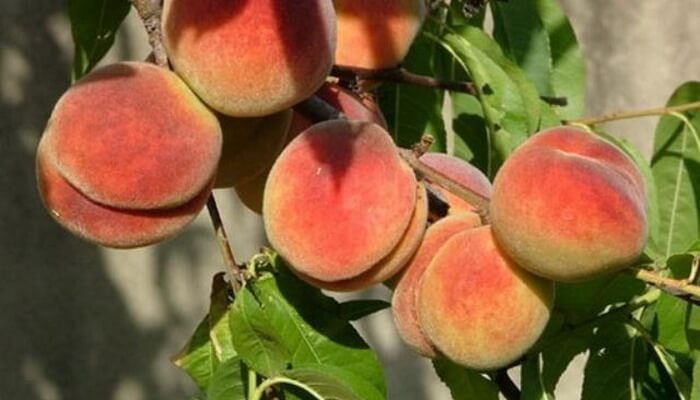

Fruits are round, weighing 120-160 g. The top is slightly depressed. The peel is yellow, with red spots, of medium thickness, easily removable.
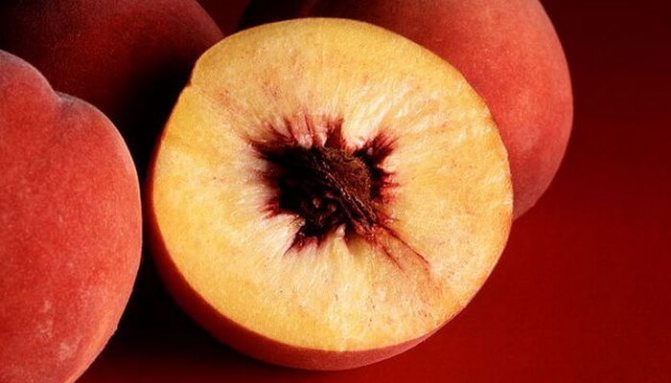

The pulp is yellow-orange, non-fibrous, sweet. Ripens in late August - early September. Fruiting at 4-5 years of tree life. The variety is frost-hardy, generative buds are not damaged by spring frosts.
Harvesting and storage
Harvesting begins with the arrival of the last summer month. Depending on the region where the fruit trees are grown, fruit harvesting begins in early August.
After harvesting, the fruits are recommended to be eaten immediately, or used for the preparation of semi-finished products, conservation or blanks. Shelf life after collection without refrigeration is 4–5 days.
Based on this, it is recommended to transport peaches for sale chilled.
Growing peach trees of the Ambassador of Peace variety does not require much effort, since the main care consists in watering and feeding, which are done several times during the growing season of the tree. The variety brings a large harvest and has good taste and marketability.
Peach "Domestic" (with photo and description)
Peach "Domestic" - a tree with a broadly oval crown, reaching up to 8 m in height.


Fruits are round-ovoid, slightly beveled, weighing 80-120 g. Creamy skin, with a bright raspberry or carmine blush, dense, with velvety pubescence. The pulp is white, friable, fleshy, moderately sweet with sourness. Variety "Domestic" early ripening.
Our gallery contains photos of peach varieties:
Photo gallery
The best varieties of nectarine: photo and description
As you know, nectarine is a kind of peach, which differs from it with a smooth skin without pubescence, smaller fruit size and firmer pulp. A peach of the nectarine variety is more aromatic and tastier, but its pulp is not as juicy and loose as that of an ordinary peach.
Despite the huge variety of nectarine varieties, those that are stored longer and are better transported are popular. In addition, there are large-fruited varieties with a fruit weight of up to 200 g.
New winter-hardy varieties are quite promising and suitable for growing in a garden plot, such as:
Voronezh peach: description of the variety and its characteristics
Voronezh bush peach is a medium early variety with fruit ripening in the first or second decades of September.
The bushes of this stone fruit culture are low - the height of the central trunk usually does not exceed 2.0 m.This peach also has a columnar variety - a compact tree up to 1.6-1.7 m high.Thanks to this size, this peach is easier to care for, as well as collection of ripe peaches.
Photo of Voronezh peach
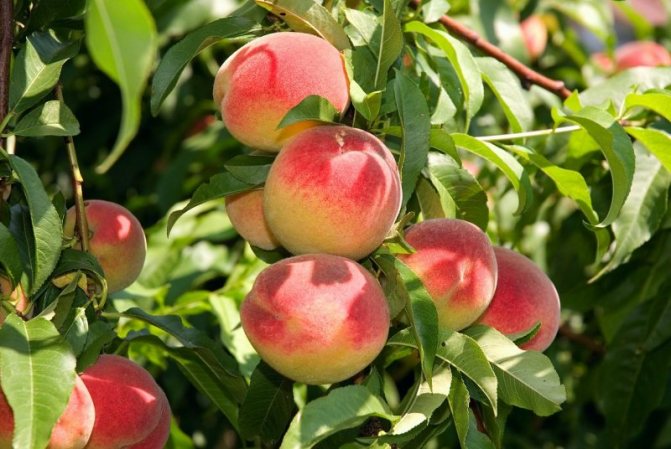

The central trunk of this shrub is dark brown, very flexible. The foliage is oblong, light green, with small teeth at the edges. The shoots on which the fruits appear are distinguished by elasticity, thin and flexible, not fragile. Their color is like that of the central trunk.
The flowers of the Voronezh bush peach are large with a pale pink color of the petals, after each of them an ovary is formed.
Interesting!
The ripe fruits of the Voronezh are round, medium in size, weighing about 110 g. The columnar peach hangs out more - up to 170 g.
The skin is thin, fleecy, harsh, rich orange color with a characteristic red blush that covers most of the ripe fruit surface. The color of the juicy porous pulp is dark yellow. The taste of the collected peaches is sweet with a slight sourness.
Peach varieties!
Peach greensboroPeach Redhaven
The harvested crop can be transported over long distances, while the fruits do not "crush" and do not burst, do not lose their beautiful appearance and taste. Ripe peaches can be stored in the refrigerator for up to a week, during which time they do not spoil and do not lose their sweetness.
Since this variety belongs to brunions, it is impossible to separate the bone from the pulp even in overripe fruits.
Voronezh peach is distinguished by its endurance and the ability to bear fruit from the second season after planting in a permanent place. If this perennial is cut correctly, then it bears fruit better, without taking up a lot of space in the garden.
At the genetic level, the Voronezh peach has a high resistance to long periods of drought, an abundance of sun on the site during the day. The more sunlight hits the ripening fruits, the more sugars are formed in them, and the sweeter the peaches.
Peach Voronezh - video
Watering this shrub should be moderate - the soil should be moist, but without stagnant moisture
... At a high humidity, some of the ovaries fall off.
Due to the high yield and compactness of the bushes, the Voronezh peach is grown not only on personal garden plots, but also on an industrial scale for further sale. Ripe peaches are eaten fresh, but many housewives claim that ripe fruits of this variety make delicious aromatic jam and compotes.
![Tinkoff (Debit Card) [CPS] RU](https://bgn.imadeself.com/wp-content/uploads/tinkoff-debetovaya-karta-cps-ru13.jpg)
![Tinkoff (Debit Card) [CPS] RU](https://bgn.imadeself.com/wp-content/uploads/tinkoff-debetovaya-karta-cps-ru13.jpg)
When grown on an industrial scale, ripe products are delivered to stores for sale, as well as for making wort for juice.
Photo gallery
The best varieties of nectarine:
Photo gallery
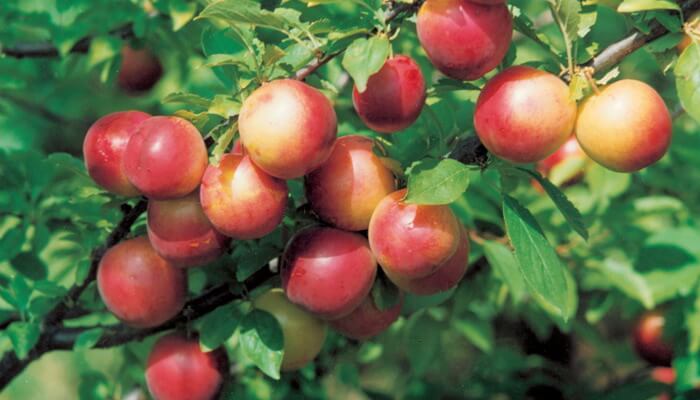

Nectarine "Krasnodarets" - a tree reaching 4-6 m in height with a wide spreading crown. The flowers are pink, with oval pink petals. Fruits are small, elliptical, weighing up to 40 g. The peel is orange-yellow, with a dark red blush. Average taste. The yield is high. Resistance to powdery mildew and klyasternosporiosis is average.
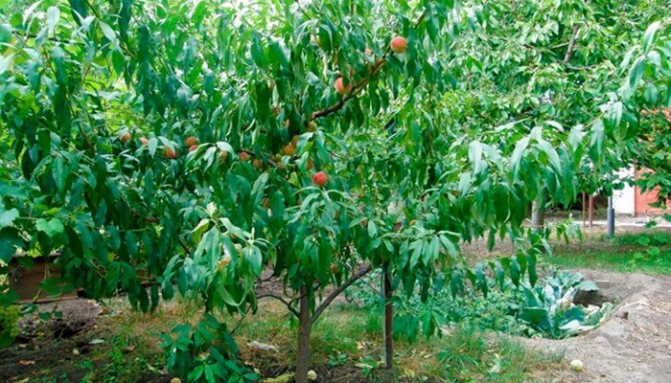

Nectarine "Skif" - a powerful, vigorous tree up to 10 m in height. The crown is wide-pyramidal. Fruits are round, weighing up to 120-180 g. The skin is yellow with a red blush. The bone is free. Ripens in mid-August. "Skif" is appreciated for its regular abundant yield, resistance of flower buds to frost and fruits of pleasant taste.
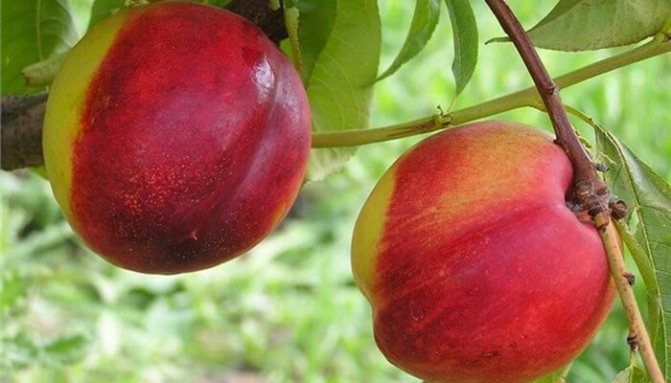

Lola nectarine - Uzbek variety. The trees are medium-sized, up to 5-6 m in height. The crown is broadly oval, slightly spreading. The flowers are pink-shaped. Fruits are broadly oval, weighing up to 100 g with a weakly expressed abdominal suture. The skin is greenish-creamy with a dark red blush that occupies most of the fruit.The skin is of medium density and thickness, easily separating from the pulp. The pulp is white, fibrous, aromatic, sweet. The taste is satisfactory. The bone does not come off. Lola nectarine is self-fertile, early maturing. Increased winter hardiness.
You can see the varieties of nectarine and their external features in the photo below:
Diseases and pests, the fight against them
One of the main advantages of the Veteran peach is its extremely high resistance to diseases, including the most dangerous ones: clotterosporia and cytosporosis. It has somewhat less immunity to powdery mildew. It can appear as early as May, when a gray-white bloom appears on the tops of young shoots, after which the leaves curl and crumble, after which it is time for the shoots themselves to dry. The disease can also spread to the fetus. The disease is not fatal, but it greatly weakens the trees, affects productivity and winter hardiness. Severely affected shoots should be cut off and burned, and trees should be sprayed with antifungal drugs at the first signs of damage. Immediately after flowering, Topaz and Tiovit-Jet are considered the most effective, in summer it is better to use Fitosporin.
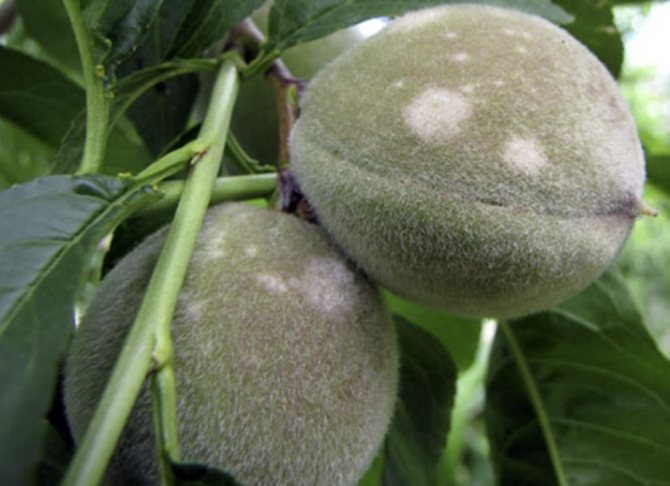

Powdery mildew can also affect fruits
Much more often the Veteran peach is harmed by the peach aphid. Preventive measures are the usual sanitary measures (keeping the tree in order, and the trunk circle clean). When a pest appears, you can use folk remedies (spraying with infusions of tobacco dust, garlic, wormwood, etc.), but this insect multiplies so quickly that you usually have to resort to purchased drugs. Fortunately, most common insecticides (for example, Iskra or Inta-Vir) are effective against aphids, but Fitoverm and Biotlin are considered less dangerous to humans. Any drugs must be used strictly according to the instructions on the package.
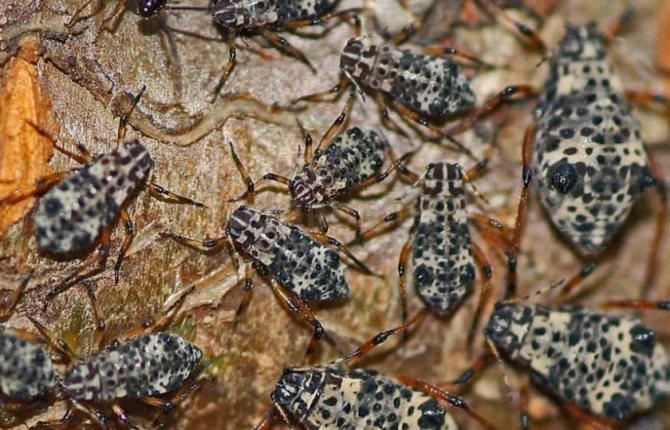

Peach aphid looks somewhat different from others.
Photo gallery
Having chosen a certain variety, you need to provide the plant with a sufficient amount of light. Landing sites must be protected from wind and drafts, located on high ground. You should not choose a low-lying area or a ravine for this culture, where cold air accumulates.
In terms of soils, the tree grows and bears fruit equally well on any drained nutrient soil. To create drainage, it is necessary to fill in a layer of gravel or brick chips at the bottom of the pit. Fertilizers are applied to poor soil a year before planting.
Today, peach breeding is practiced in many countries. It is noteworthy that this culture has gained immense popularity in recent years, displacing most other stone fruit crops. The most important tasks facing breeders are to increase winter hardiness, fruit transportability, and disease resistance.
The longevity of peach orchards is low, an average of 15-20 years. Under unfavorable conditions, it decreases to 10-12 years, under favorable conditions it increases to 30-40 years. Some individuals are able to live up to 50 years.
Voronezh peach: how to properly plant seedlings
It is possible to plant the culture of the bush Voronezh peach in open ground both in the spring and in the autumn.
... So that the trees do not freeze over the winter, the landing dates in each region may differ.
In the Central regions, this peach can be planted in early October.
... In the Far East, Siberia and the Urals, it is better to postpone the planting of plants in the spring, so that they have time to acclimatize and get stronger before winter, and the roots have grown sufficiently.
The Voronezh peach planting site should be well lit by the sun and protected from gusts of cold winds. The best type of soil is medium loamy with good air permeability and moisture exchange. Acidity - neutral or slightly alkaline.
The main condition is that there should not be too much calcium in the soil, because the Voronezh peach does not develop well in such soils.
Many gardeners prefer to purchase seedlings already with varietal stock, which can be bought in a specialized store.
The main requirements for Voronezh seedlings:
- the plant must have at least 3 shoots;
- bark - no visible damage;
- roots - healthy, free from damage and dry pieces.
There is another way to grow the Voronezh peach variety - from the stone. It is longer, but also quite effective. Plants grown from seeds retain all their parental qualities.
How to plant a peach correctly
Voronezh peach pits are planted in a pot with a nutrient substrate at the beginning of September, and the sprout usually appears already at the end of April - the first decade of May
... At home, this bush peach is grown throughout the year, and with the onset of warm spring days, along with a lump of earth, the plant is transferred into a prepared hole.
The diameter of the planting pit is 0.5 m at the same depth
... At the bottom of the pit, a drainage layer with a thickness of at least 10 cm is laid out. Fine gravel or crushed stone can be used as drainage. Then a nutrient substrate is poured into the pit, made up of garden soil, humus and a kilogram of ash.
The seedling, together with the earthen lump, is installed vertically, the remaining soil is poured into the pit and compacted well. For each planted tree, you need to add 15-20 liters of water.
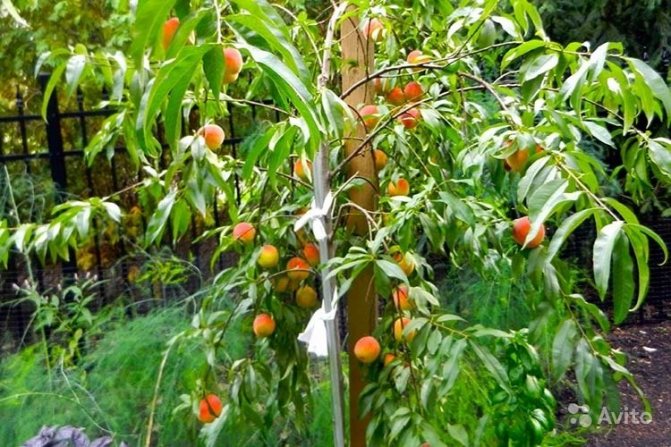

After planting, the peach shoots should be pruned, leaving only 25 cm of the total length.



